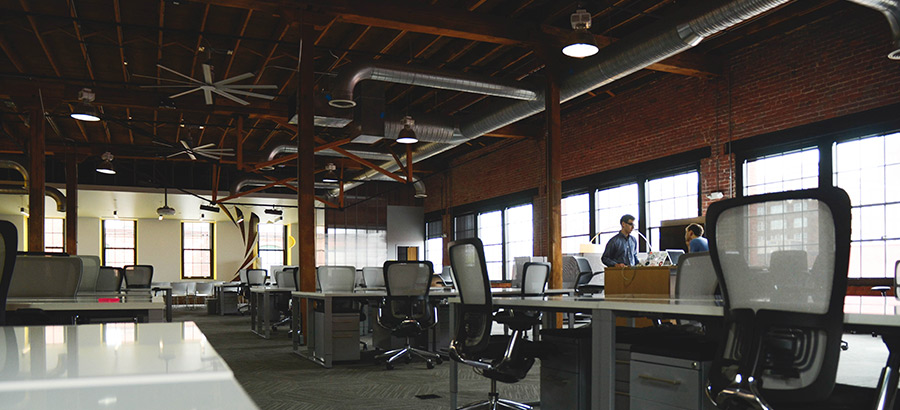By Jim Trudeau, Chief Design Officer, Cummings Properties
With unemployment at very low levels on the North Shore and throughout Greater Boston, companies are looking for ways to enhance their facilities or even relocate in an effort to recruit and maintain talent. In this environment, corporate tenants are reviewing workplace alternatives, which include technology upgrades, open offices, live-work-play locations, multiple amenities, sustainability, and remote workforces.
It’s important to be knowledgeable about cutting-edge workplace strategies, but it’s also critical that organizations be discerning about what’s just trendy and what’s really in their best interests. Why? Because, however exciting the latest “bells and whistles” may initially seem, they may or may not be good for the bottom line, and they may result in needless risks, including lost time and compromised performance.
So, a reality check may be in order to see what works and what doesn’t for your workplace.

Understanding the Variables and the Options
Of course, no two organizations are exactly the same, and that begs the need for customized workplace solutions that will vary based on your size, business goals, growth plans, industry sector, and demographics.
In planning for your ideal office space, consider the following:
• Technology. Providing advanced technology tools, particularly coveted by Millennials and Gen Z, is perhaps the most vital factor in attracting new professionals and improving employee engagement (though concessions for less tech-savvy Baby Boomers are also prudent). High-speed Internet, data sharing, and connectivity throughout the workplace are expected, while more specialized tools like video conferencing may be desirable as well, though they come at a price.
• Open offices. Studies show that flexible open office environments are gaining traction as companies strive to cut real estate costs by reducing rigid construction and promoting collaboration. While some research shows that this environment promotes productivity, it doesn’t work for everyone. Pushback often comes from senior staff members who value their privacy and are annoyed by distractions. The answer is often a balance, a hybrid setting with common areas, work stations, and limited private offices that accommodates future changes.
• Live-work-play. Companies can benefit by recognizing that their employees have lives outside of work. A live-work-play dynamic accents convenience, with easy access to dining, shopping, banking, exercising, healthcare, day care, and housing. In this light, amenity-rich office parks provide attractive communities that consider employees’ lifestyles and well-being. This is all about location, and on-site services such as ample free parking and prompt snow removal are key benefits. An alternative to more congested urban areas such as Boston, Cambridge, and Waltham is the vibrant, award-winning Cummings Center in Beverly. With 2 million SF accommodating 500 businesses, it is the largest, corporate park in the suburbs, a mixed-use “city within a city” that also features significantly lower prices than other metro areas.
• Atmosphere. In addition to in-house technology, amenities, and aesthetics (such as building appearance, landscaping, and fountains), office features such as natural lighting, clean air, acoustics, and ergonomic considerations may be other key parts of the prospective client package. These environmental factors are often tied to the growing wellness movement that takes into account the holistic needs of employees.
• Sustainability. This isn’t a recent trend, and the health benefits of “going green” are well-documented, but it’s debatable whether the considerable expense and exhaustive paperwork associated with LEED certification is worth it. Also, the myth that the suburbs always lag behind the larger high-rent districts doesn’t always hold true. Cummings Center, for example, features innovative energy initiatives, including large roof-top solar arrays, and commuter-friendly transportation options such as public transit and bike racks. Cummings Center also demonstrates that you can go green without spending excessive of amounts of green!
• Remote workers. Virtual offices help to lower operating costs—with fewer dedicated seats as well as co-working provisions—and they make sense for employees such as sales staff who are often on the road and are self-motivated. Many managers fear, however, that this arrangement will result in a loss of control and accountability. Some studies show that virtual workers work more hours and are more efficient than in-house staff. Ultimately, employees need to return to home base for face time, and they should ideally consider the workplace a welcoming “home away from home.”

Recognizing Tenant Advantages
In short, there are pros and cons of most workplace strategies, with data to support different models. But in the final analysis, what matters most is how tenants can realize optimal results within a reasonable price and timeframe.
With this in mind, more corporate space users are discovering the value of engaging a service provider that offers one-stop shopping and integrated services, with leasing, design, construction, engineering, financing, legal services, and property management working together under one roof. This business model streamlines and consolidates services, precluding the need for extra time and expenses associated with outsourcing to third parties.
At the end of the day, companies are encouraged to perform due diligence by reviewing market conditions and potential workplace solutions, including flexible designs that can accommodate, but not be limited by, cool and creative options. As you strive to attract employees and hone your competitive edge, look for cutting edge, but be leery of the bleeding edge.
 Jim Trudeau, chief design officer for Cummings Properties—based in Woburn, Mass., and serving 11 Greater Boston communities—features extensive in-house leasing and design departments that integrate multiple services under one roof. Cummings operates 11 million square feet with a portfolio that accommodates offices, healthcare facilities, labs, restaurants, retail storefronts, warehouses, co-working spaces, executive suites, luxury condominiums, and more. Cummings supports hundreds of local charities, with Cummings Foundation already awarding more than $200 million in grants to worthy nonprofits in Greater Boston.
Jim Trudeau, chief design officer for Cummings Properties—based in Woburn, Mass., and serving 11 Greater Boston communities—features extensive in-house leasing and design departments that integrate multiple services under one roof. Cummings operates 11 million square feet with a portfolio that accommodates offices, healthcare facilities, labs, restaurants, retail storefronts, warehouses, co-working spaces, executive suites, luxury condominiums, and more. Cummings supports hundreds of local charities, with Cummings Foundation already awarding more than $200 million in grants to worthy nonprofits in Greater Boston.
